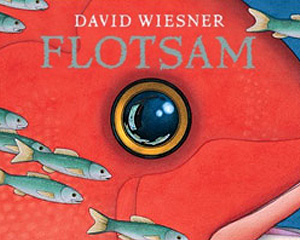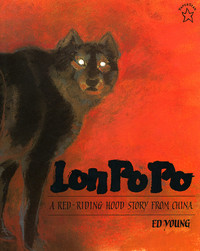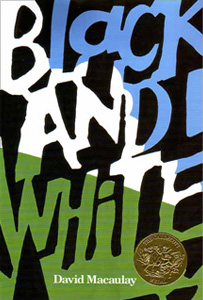
"The Three Little Pigs" is a fable about three pigs who build their houses of different materials. A Big Bad Wolf blows down the first two pigs' houses which are made of straw and sticks respectively, but is unable to destroy the third pig's house that is made of bricks. The printed versions of this fable date back to the 1840s, but the story is thought to be much older. The earliest version takes place in Dartmoor with three pixies and a fox before its best known version appears in English Fairy Tales by Joseph Jacobs in 1890, with Jacobs crediting James Halliwell-Phillipps as the source. In 1886, Halliwell-Phillipps had published his version of the story, in the fifth edition of his Nursery Rhymes of England, and it included, for the first time in print, the now-standard phrases "not by the hair of my chiny chin chin" and "I'll huff, and I'll puff, and I'll blow your house in".

The Big Bad Wolf is a fictional wolf appearing in several cautionary tales, including some of Grimms' Fairy Tales. Versions of this character have appeared in numerous works, and it has become a generic archetype of a menacing predatory antagonist.

Mo Willems is an American writer, animator, voice actor, and children's book author. His work includes creating the animated television series Sheep in the Big City for Cartoon Network, working on Sesame Street and The Off-Beats, and creating the popular children's book series Elephant and Piggie.

Tony M. DiTerlizzi is an American fantasy artist, children's book creator, and motion picture producer.
Postmodern picture books are a specific genre of picture books. Characteristics of this unique type of book include non-linear narrative forms in storybooks, books that are "aware" of themselves as books and include self-referential elements, and what is known as metafiction.

Lane Smith is an American illustrator and writer of children's books. He is the Kate Greenaway medalist (2017) known for his eclectic visuals and subject matter, both humorous and earnest, such as the contemplative Grandpa Green, which received a Caldecott Honor in 2012, and the outlandish Stinky Cheese Man, which received a Caldecott Honor in 1992.
Evaline Ness was an American commercial artist, illustrator, and author of children's books. She illustrated more than thirty books for young readers and wrote several of her own. She used a great variety of artistic media and methods.

Three Little Pigs is a 1933 animated short film released by United Artists, produced by Walt Disney and directed by Burt Gillett. Based on the fable of the same name, the Silly Symphony won the 1934 Academy Award for Best Animated Short Film. The short cost $22,000 and grossed $250,000.

David Wiesner is an American illustrator and writer of children's books, known best for picture books including some that tell stories without words. As an illustrator he has won three Caldecott Medals recognizing the year's "most distinguished American picture book for children" and he was one of five finalists in 2008 for the biennial, international Hans Christian Andersen Award, the highest recognition available for creators of children's books.

The Egg Tree is a 1950 book by Katherine Milhous that won the 1951 Caldecott Medal. It is based on the author's family tradition and tells the classic tale of a Pennsylvania Dutch Easter, with its main characters being Katy and Carl. One day, near Easter, they look for Easter eggs and found eggs that their grandmother had painted on a tree. They are interested, so they ask their grandmother about the eggs. They eventually create one, and it becomes a big success the next Easter.

Flotsam is a children's wordless picture book written and illustrated by David Wiesner. Published by Clarion/Houghton Mifflin in 2006, it was the 2007 winner of the Caldecott Medal; the third win for David Wiesner. The book contains illustrations of underwater life with no text to accompany them.

Lon Po Po: A Red-Riding Hood Story from China is a children's picture book translated and illustrated by Ed Young. It was published by Philomel in 1989 and won the 1990 Caldecott Medal for distinguished American illustrated books for children.

Black and White is a 1990 postmodern children's picture book by David Macaulay. Published by Houghton Mifflin Company, it received mixed reviews upon its release, but it was the recipient of the Caldecott Medal for illustration in 1991. The book tells four overlapping stories, each drawn with a distinct visual style. The four stories are "Seeing Things", about a boy on a train trip by himself, "Problem Parents", about siblings whose parents behave differently one night, "A Waiting Game", about people waiting for a train, and "Udder Chaos", about cows who escape and then return to their field.

Tuesday, written and illustrated by David Wiesner, is a 1991 wordless picture book published by Clarion Books. Tuesday received the 1992 Caldecott Medal for illustrations and was Wiesner's first of three Caldecott Medals that he has won during his career. Wiesner subsequently won the Caldecott Medal in 2002 for The Three Pigs, and the 2007 medal for Flotsam.

Jon Klassen is a Canadian writer and illustrator of children's books and an animator. He won both the American Caldecott Medal and the British Kate Greenaway Medal for children's book illustration, recognizing the 2012 picture book This Is Not My Hat, which he also wrote. He is the first person to win both awards for the same work.

A Ball for Daisy is a 2011 children's wordless picture book written and illustrated by Chris Raschka. The book tells the story of a dog named Daisy, who has a beloved ball destroyed and then replaced. Raschka won the 2012 Caldecott Medal for his illustrations in the book. The creation of the book took years but was praised for its ability to evoke emotion in the reader. A sequel, Daisy Gets Lost, was released in 2013.
Baby Bear and the Big, Bad, Wolf is a 1996 children's play by Chet Frame and Jan H. Wolfe. The show combines the fairy tales Little Red Ridinghood, Goldilocks and the Three Bears, The Three Little Pigs, and Hansel and Gretel.

The Thrifty Pig is a four-minute educational short animated film made by Walt Disney Studios for the National Film Board of Canada. A World War II propaganda film, it was released theatrically on November 19, 1941, as part of a series of four films directed at the Canadian public to learn about war bonds. The Thrifty Pig was directed by Ford Beebe. It is also a remake of the 1933 film of the same name.

Revolting Rhymes is a 2016 British computer-animated fantasy comedy drama television film written for the screen and directed by Jakob Schuh and Jan Lachauer, based on the 1982 book of the same name written by Roald Dahl and illustrated by Quentin Blake.

Wolf in the Snow is a 2017 wordless picture book by Matthew Cordell. The book was favorably received by critics and won the 2018 Caldecott Medal. The story has drawn comparisons to fairy tales like Little Red Riding Hood. The nearly wordless book tells the story of a girl and wolf who each get lost in the snowstorm. Cordell used distinctive illustration techniques for the girl and the wolf.

















